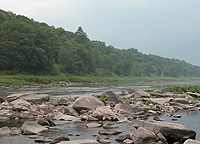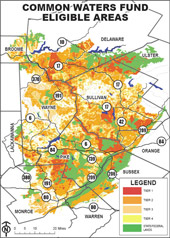Background on Forests and Water Quality
Why Forests?
Forests are the most effective land cover for maintenance of water quality. They serve as natural sponges, collecting and filtering rainfall and releasing it slowly into streams. Forest cover has been directly linked to drinking water treatment costs – the more forest in a source water watershed, the lower the treatment costs.
The forests of the headwaters region of the Delaware River provide a number of benefits. Forests provide significant benefits by filtering sediments and other pollutants from water before it reaches the stream. Forest buffers of even moderate width provide numerous water quality benefits. Forest buffers slow down the flow of water, allowing suspended sediments to fall out. They capture of sediment also reduces phosphorus loading in the receiving water body because many forms of phosphorus attach to sediment. Buffers will also filter nitrogen, pesticides, herbicides, and coliform bacterias, contributing to the water quality of the receiving stream. Generally, maintenance of forests and forest buffers in the headwaters areas of watersheds has a greater result in lower nutrient concentrations downstream than maintenance of forests in the lower part of a watershed. This illustrates the benefits the forested upper basin as a whole provides for the lower basin – loss of forests in the upper basin will have significant impacts on the quality of water flowing to the lower basin.
Increase in urban cover in watersheds results in significant changes in watershed function. These changes occur as a result of increased impervious and low-pervious cover (e.g. urban and suburban lawns, while not impervious like pavement, do not function similarly to forests in terms of encouraging infiltration, filtering nutrients, etc.). Urbanization increases storm water flows and decreases natural nutrient cycling processes. This results in higher peak flows and increased nutrient and sediment loading. Forests are typically a sink for pollution – they trap and filter sediment, nutrients, and other pollutants. An urbanized watershed is typically a source of pollution including sediment, nutrients, road salts and other road contaminants, total dissolved solids, and other pollutants. Urbanization also has a short-term, local impact of increasing sediment loading in streams.






